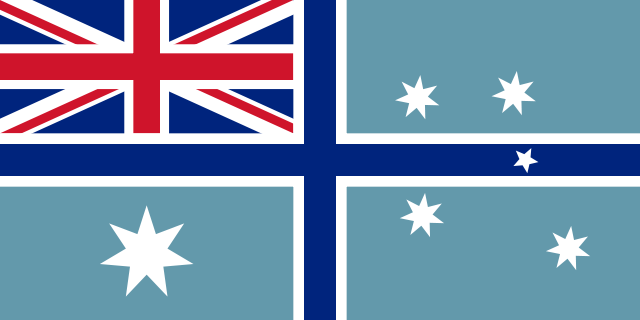 |
This is a file from the Wikimedia Commons. Information from its description page there is shown below.
Commons is a freely licensed media file repository. You can help.
|
Summary
| Description |
Civil Air Ensign of Australia |
| Date |
22 February 2012 |
| Source |
(see below for transcript) |
| Author |
- Original version by Butterstick
- New, more accurate code by NikNaks
|
Licensing
| Public domainPublic domainfalsefalse |
 |
This work has been released into the public domain by its author, NikNaks. This applies worldwide.
In some countries this may not be legally possible; if so:
NikNaks grants anyone the right to use this work for any purpose, without any conditions, unless such conditions are required by law.Public domainPublic domainfalsefalse
|
Specification
Included in the Gazette is a very detailed construction sheet. Unlike the New Zealand case, the dark blue cross itself is 1/10 the width of the fly, with fimbriations 1/3 of its width, leading to a total width for the cross+fimbriations of 1/6 the width of the fly, rather than 1/5. The Union Jack is constructed following hte usual rules in a 5:11 canton. The Commonwealth Star has, as in the national flag, an outer diameter 3/5 the width of the Union Jack. (Of course, in this case, this is not the same as the 3/10 of the fly specified in the Flags Act.)
The stars of the Southern Cross are tilted 45 degrees, so that Alpha and Gamma lie on the line from the lower fly corner to the centre of the top of the flag. They definitely have points pointing in that direction, although to the casual glance, the difference between pointing this way and pointing up in 7-pointed stars is not that significant. Say this line is 'A' and it contains a point 'B', the centre of the southern cross. Then the centre of each star is given as:
- Alpha: 1/3 of the width of the fly from B along A towards the lower fly.
- Beta: 1/4 the width of the fly from A towards the bottom of the flag along a line at right angles to A, meeting A 1/16 the width of the fly from B towards the top of the flag.
- Gamma: 1/3 of the width of the fly from B along A towards the top of the flag.
- Delta: 2/9 the width of the fly from A towards upper fly along a line at right angles to A meeting A 1/16+1/15 the width of the fly from B towards the top of the flag.
- Epsilon: 1/10 the width of the fly from A towards upper fly along a line at right angles to A, meeting A 1/24 the width of the fly from B towards the lower fly.
Alpha, Beta, Gamma and Delta have outer diameters 1/7 the width of the fly and are 7 pointed, Epsilon has outer diamter 1/12 the width of the fly and is five pointed. All stars (including the Commonwealth Star) have inner diameters 4/9 their outer diameter. This means that the Southern Cross is identical to that in the national flag, except for the tilt and the movement of the centre of the cross (B) from the centre of the fly towards the lower fly corner. It is not exactly clear where B is. It could be 1/16 thh width of the fly from the centre, so that the line from the centre of Beta meets A in the centre of the fly, but it looks similarly close to the point which makes the centre of Epsilon fall vertically in the centre of the main cross. Either way, the placement is obviously intended to ensure that Epsilon is in the cross and all the others are clear of it.
File usage
The following pages on Schools Wikipedia link to this image (list may be incomplete):
This file contains additional information, probably added from the digital camera or scanner used to create or digitize it. If the file has been modified from its original state, some details may not fully reflect the modified file.
All five editions of Schools Wikipedia were compiled by SOS Children's Villages. SOS Children's Villages believes that a decent childhood is essential to a happy, healthy. Our community work brings families new opportunities through education, healthcare and all manner of support. Why not try to find out more about sponsoring a child?




